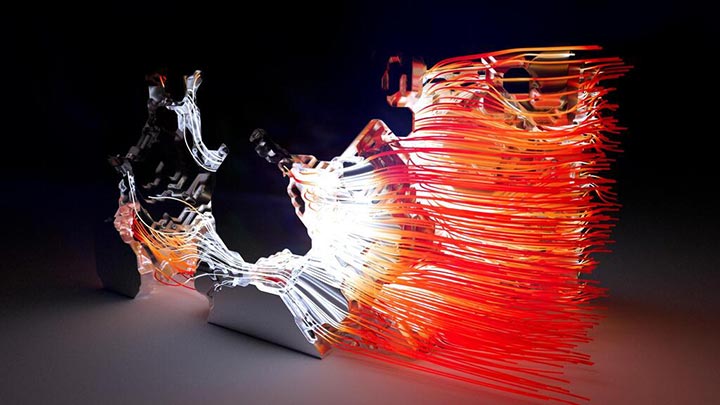Extreme Fast Charge Batteries
NLR researchers are using electrochemical models to improve lithium-ion (Li-ion) battery designs, accelerate electric vehicle (EV) charging speeds, and optimize energy use, particularly for medium- and heavy-duty applications.

This model shows flux of Li-ions moving through a battery from the electrolyte into the negative electrode. Bright parts depict high flux as the ions must converge and travel faster through constricting pores. Visualization by NLR
The extreme fast charging of batteries is key to allowing drivers to travel faster and further. However, the Li-ion batteries used in EVs are resistant to these expedited charging speeds, and the energy-dense Li-ion batteries capable of fast charging are significantly more expensive.
However, the Li-ion batteries used in EVs are resistant to these expedited charging speeds, and the energy-dense Li-ion batteries capable of fast charging are significantly more expensive
Advanced Electrochemical Modeling for Batteries
NLR uses electrochemical models to understand the performance and degradation of batteries under fast charge. This research identifies pathways to improve fast charge capabilities in Li-ion batteries by optimizing electrode and cell design. Model-guided optimization speeds up the development of next-generation battery designs for fast-charge time, high energy, low cost, and long lifetime.
Macrohomogeneous Models
Macrohomogeneous models describe the transport of lithium through the battery and identify reaction rates across the thickness of electrodes. Researchers use these models to capture major rate limitations and identify novel approaches to achieve fast charge.
Microstructure Models
Microstructure models, such as the Microstructure Analysis Toolbox, are based on 3D geometry of active material particles and demonstrate how particles are packed into the electrode. These models quantify the tortuosity and distance that ions must travel as well as constrictions they face when moving across the electrode.
Degradation Models
Degradation models measure the effect of key degradation mechanisms, such as lithium plating or cathode cracking, on the overall performance of the battery. Researchers use degradation models to compare different reactions within the battery to evaluate new battery materials for improved performance.
Enhancing Electrolyte Transport for Faster Charging
Today's thin-electrode Li-ion batteries can already charge in less than 15 minutes; however, those cells are 20% less energy-dense and cost twice that of thick-electrode cells. While they offer cost and energy advantages, thick-electrode cells suffer from severe lithium-concentration gradients across their electrodes during fast charge. Technical solutions are needed to enhance electrolyte transport and mitigate damage due to lithium plating, active material cracking, and excessive heat generation. These barriers limit the battery's lifetime and increase the need for expensive thermal management.
Researchers are using their understanding of physical barriers to develop novel electrolytes, advanced electrodes, adaptive electrochemical protocols, and optimal thermal controls that, together, meet the U.S. Advanced Battery Consortium goals of 80% charge in <15 minutes of 275 watt-hour/kilogram cells, with 1000-cycle, 15-year lifetime. Faster lithium transport through the electrolyte is the primary technical improvement needed to fast charge high-loading batteries.
NLR's work seeks to achieve fast electrolyte transport in several ways: improved electrolyte formulations, low-tortuosity advanced electrode designs, and appropriate use of elevated temperature, or “good heat,” which enhances electrolyte diffusivity and conductivity during charging, albeit with some penalty to calendar life.
Besides improving lithium transport, proposed electrolytes will enhance high-temperature lifetimes and improve cell-level thermal transport properties. Innovative charging protocols will further improve fast-charge acceptance and increase lifetime with machine-learned health adaptivity.
Publications
Lithium-Ion Battery Life Model With Electrode Cracking and Early-Life Break-In Processes, J. Echem Soc. (2021)
Extended Cycle Life Implications of Fast Charging for Lithium-Ion Battery Cathode, Energy Storage Materials (2021)
Quantifying the Influence of Charge Rate and Cathode-Particle Architectures on Degradation of Li-ion Cells Through 3D Continuum-Level Damage Models, Journal of Power Sources (2021)
Artificial Generation of Representative Single Li-ion Electrode Particle Architectures from Microscopy Data, Nature Computational Materials (2021)
Mapping the Architecture of Single Electrode Particles in 3D Using Electron Backscatter Diffraction and Machine Learning Segmentation, Journal of Power Sources (2021)
Contact
Share
Last Updated Dec. 6, 2025
